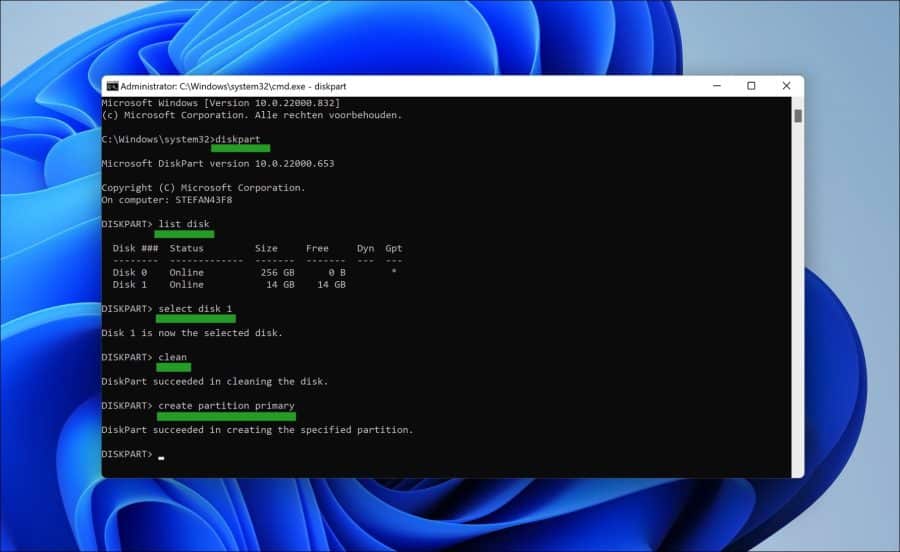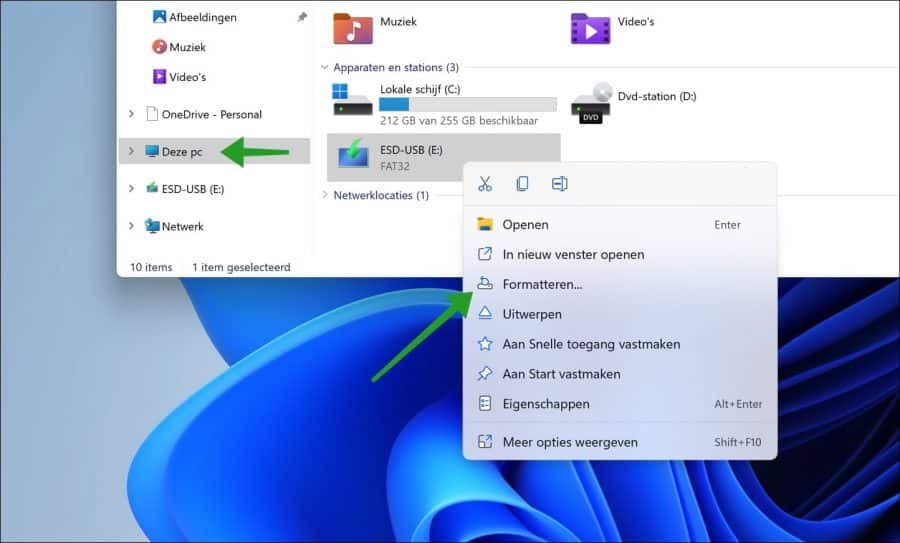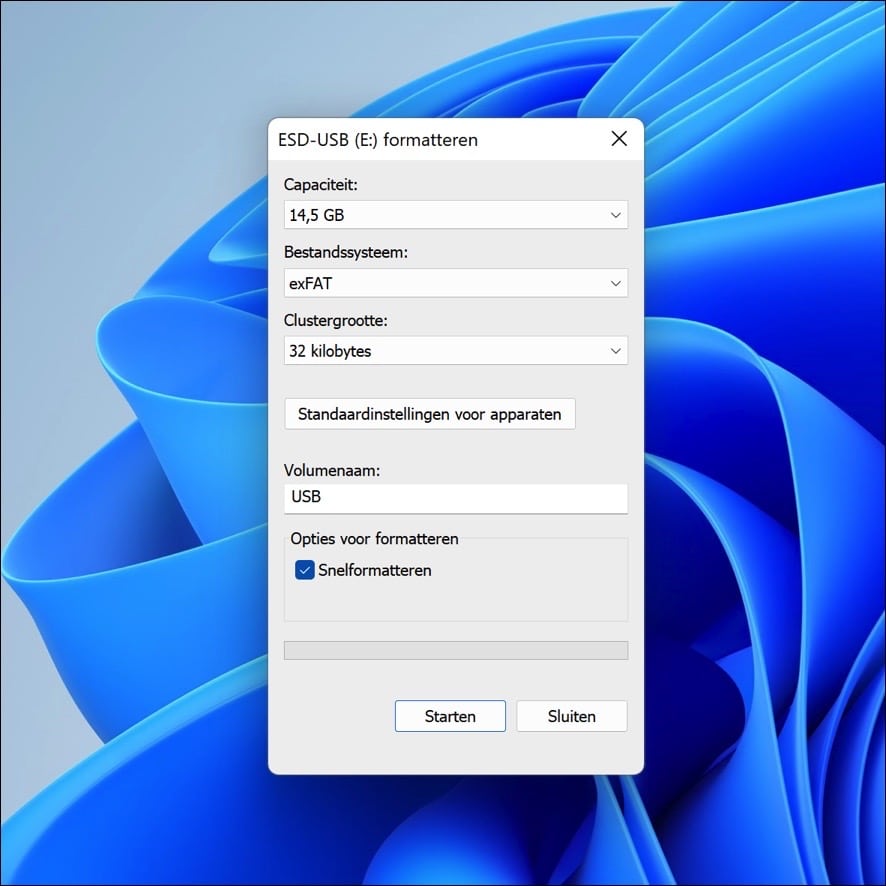Als u een USB stick wilt formatteren dan kiest u ervoor om de USB stick helemaal leeg te maken en het te formatteren in een bepaald bestandssysteem, bijvoorbeeld FAT32, NTFS of exFAT. U kunt de USB stick dan opnieuw gebruiken met nieuwe data.
Er bestaat een mogelijkheid dat de USB stick niet volledig leeg wil formatteren. Daarmee bedoel ik dat de totale capaciteit van de USB stick bijvoorbeeld 16GB is, maar dat Windows bij het formatteren aangeeft dat de USB stick geformatteerd kan worden tot 14GB.
Er blijft dan nog 2GB aan ruimte over op de USB stick die u niet kunt gebruiken. De totale capaciteit van de USB stick wordt niet gebruikt.
Meld u dan aan voor onze nieuwsbrief.
Om dit probleem op te lossen kunt u onderstaande instructies gebruiken. Wat u gaat doen is de USB-stick terugzetten naar de oorspronkelijke volledige capaciteit in Windows 10 of Windows 11. Ook kunt u deze instructies gebruiken om het USB apparaat normaal te formatteren.
USB stick volledig formatteren in Windows 11 of Windows 10
Deze instructies kunt u ook uitvoeren met een externe harde schijf.
Klik met de rechtermuisknop op de Startknop. In het menu klik op uitvoeren. In het uitvoeren venster type: cmd.exe en druk op de toetsencombinatie CTRL + SHIFT + ENTER. U gaat nu het Opdrachtprompt uitvoeren als Administrator.
Plaats nu de USB stick in de computer en zorg dat de USB stick wordt herkend door Windows.
Staat er nog data op de USB of externe schijf die u nodig heeft? Stel deze dan nu veilig door de data te kopiëren naar een veilige map op uw PC.
U gaat nu een aantal opdrachten uitvoeren. Deze opdrachten geeft u in en bevestigt u met de enter toets. Lees stap 3 goed door en maak de juiste keuze.
- diskpart
- list disk
- select disk X
X vervangt u door het cijfer wat aangegeven wordt in het resultaat “list disk” voor de USB stick. U ziet hier “Disk 0”, “Disk 1”, “Disk 2” e.d. in een kolom. U geeft het nummer in van de disk die de USB stick toegewezen heeft gekregen. U kunt de “Size” kolom gebruiken om te bepalen welk disk nummer de USB stick betreft. Zorg dat u het goede disk nummer selecteert! Geen idee? Te moeilijk? Sluit dan af. - clean
- create partition primary

Sluit nu het Opdrachtprompt venster. Open de Windows verkenner. Klik eerst op “Deze PC” aan de linkerzijde en klik met de rechtermuisknop op de schijfletter die de USB stick toegewezen heeft gekregen. In het menu klik op “Formatteren”.

U gaat nu de USB formatteren met de maximale capaciteit. De maximale capaciteit ziet u in “Capaciteit”.
Ik raad aan om de USB te formatteren in het exFAT bestandssysteem. Dit bestandssysteem kunt u op een Windows PC als een Mac computer gebruiken. Linux is ook mogelijk, met wat aanpassingen.
Clustergrootte hangt af van de totale capaciteit van de USB stick of externe harde schijf. Als u de USB of schijf niet groter is dan 32GB maximale capaciteit, dan selecteert u “32 kilobytes”. Indien de capaciteit groter is dan 32GB selecteert u “128KB”.
| 7 MB–256 MB | 4 KB |
| 256 MB–32 GB | 32 Kilobytes |
| 32 GB–256 TB | 128 Kilobytes |
| > 256 TB | Niet ondersteunt door exFAT |
Let op: Als u op Starten klikt wordt alle data op de USB of externe harde schijf gewist. Dit mag duidelijk zijn ondertussen.

Ik hoop u hiermee geholpen te hebben. Bedankt voor het lezen!


Goedemorgen,
Dit leek me handig om de volledige capaciteit van mijn nieuwe seagate expansion 5TB schijf te gaan benutten.
Helaas, na stap 5 create partition primary (die eindigde als hierboven aangegeven) , was de disk helaas NIET meer zichtbaar in de explorer.
Ik kon de vervolgstappen (formatteren) dus niet meer uitvoeren.
Wat nu te doen?
Hallo, open Schijfbeheer en controleer of de schijf daar wel zichtbaar is. Wijs een nieuwe schijfletter toe of formatteer de schijf via schijfbeheer met automatische cluster grootte. Succes!